Tharp's Thoughts Weekly Newsletter (View On-Line)
-
Article A Trick That Not 1 in 100 Traders Knows by D.R. Barton, Jr.
-
-
April Is Your Last Chance This Year to...
 Exchange-Traded Funds and Notes: A Trick That Not 1 in 100 Traders Knows Exchange-Traded Funds and Notes: A Trick That Not 1 in 100 Traders Knows
by D.R. Barton, Jr.
“Things are not always what they seem; the first appearance deceives many; the intelligence of a few perceives what has been carefully hidden.”—Phaedrus, Roman Fabulist
There are many things in life that are so cool, enjoyable or useful that you’ll put up with annoying little quirks. Walt Disney World in Orlando is just such a place. With four major parks in one complex (and a couple of water parks thrown in for good measure), this is one of the great vacation destinations on the planet.
Disney runs their parks so well—they are clean, well-designed, and the park content (rides, animals, displays, etc.) is consistently exceptional. The employees, who refer to themselves as cast members, are polite and readily available at every turn. The place is so idyllic that I’m sure it was spoofed as the mythical Duloc in the original Shrek movie.
But just try to find an oatmeal cookie at Disney World.
Such was my experience when I took our kids there more than a decade ago. After a nice lunch (tasty food, served efficiently in a spotlessly clean environment) we were walking through the park and I developed a craving for a cookie. An oatmeal cookie. Rich and soft and chewy, with that whole-grain kick that only oatmeal can give. Either with or without raisins would have been fine. The problem? There were no oatmeal cookies on the whole stinkin’ property.
Oh sure, there were dozens of bakeries and little snack shops all around, and they had cookies. But only chocolate chip cookies. Every single shop, store and snack stand had the same sterile, cellophane-wrapped chocolate chip cookie. NO oatmeal. Anywhere. At any price.
I understand the virtues of standardization. It lowers costs, increases efficiency and therefore raises profit margins. But taken to an extreme, it creates what can feel like some kind of futuristic Orwellian world.
Does the absence of oatmeal cookies mean that I would never visit Disney World again? Of course not. My son and I spent a very pleasant day there recently as part of a golfing vacation. The overall benefits and enjoyment far outweigh the little inconveniences that one has to put up with.
The same can be said for the relatively new trading instruments called Exchange-Traded Products (ETPs), which include Exchange-Traded Funds (ETFs) and Exchange-Traded Notes (ETNs). ETPs are certainly one of the top financial innovations of our generation. Like mutual funds, they allow people and institutions to trade almost anything on the planet, and they have generally lower fees, more transparency and you can trade them during market hours. Like a trip to Disney World, however, there are some quirks about which traders and investors need to be aware. Let’s look at one of the issues that you have to guard against when using ETPs. While it’s fairly unusual, it has taken a toll on a lot of traders and investors in recent weeks.
ETPs Trading at a Premium Price—The Fly in the Ointment
ETPs all have a Net Asset Value (NAV) calculated at least daily. Almost all ETPs have a very good record of trading alongside the NAV. However, under certain rather unusual circumstances, the market price and the NAV can diverge. An instrument that trades higher than its NAV is said to trade a premium (meaning that traders are paying more for the ETP than for the underlying worth of its assets). When the ETP trades below NAV, it trades at a discount.
Since ETPs are traded in the open market, traders are free to drive prices away from the NAV, though in practice, arbitrage systems or arbitrageurs almost always drive the market price back toward NAV very quickly.
There are three possible reasons, however, why an ETP price might differ “legitimately” from its NAV:
- The underlying asset is traded in a low liquidity market. Sometimes, discounts or premiums show up on lightly traded assets—like more exotic bonds—just because the asset (bonds in this case) trade infrequently and carry a larger-than-normal bid-ask spread. The normal practice is to mark the NAV based-on price in the middle of the spread. If the fund has an inflow of money, then it must buy bonds at the ask price in order to create new shares. This causes certain bond funds to trade at a modest but persistent premium.
- The underlying asset is traded predominately in a foreign exchange. This problem is usually temporary. A Japanese or Chinese ETP may trade at a premium during U.S. market hours because the underlying NAV will not be adjusted until the home markets open. This type of premium (or discount) is actually very rational because the market price is anticipating what will occur when the foreign market opens. In this sense, the ETP is acting as a price discovery tool and the premium is usually erased in the next trading-day cycle.
- The underlying assets are only available in limited quantities. This is more of a special case where assets like Chinese A shares are limited to foreign investors (e.g., the Market Vector China ETF—symbol: PEK). The same applies to some Chinese renminbi funds.
These fairly obscure differences in ETP prices vs. NAV do not indicate inefficient markets, but rather are rational reasons why select ETP market prices would differ from their NAV.
Very occasionally, however, traders will run across an ETP with a large, persistent premium. An ETP issuer can stop issuing new shares as a way to control its risk exposure for a particular product, which effectively turns the ETP into a closed-end fund. Depending on demand, a limit on the number of shares creates the potential for the creation of a premium. If the issuer decides to issue new shares again after a premium has developed, the adjustment in price back to the NAV can be quite surprising and disastrous for unaware holders of the instrument.
When the ETP Market Becomes One-Sided.
Three weeks ago, I wrote that there was a serious problem with a specific volatility-based ETN, TVIX (the Velocity Shares 2x VIX Short Term ETN) and warned traders in this newsletter:
"…a word to the wise: be sure to NOT trade TVIX. It’s not what you think! Caveat emptor.”
In the three days following the article, TVIX dropped from 14.43 to 5.88—almost 60%! At least two top-tier newsletters had their subscribers long TVIX during this debacle. Here’s an excerpt of the note I sent to both of them:
“TVIX is a different and unique case that currently has little to do with trading volatility! This Velocity Shares ETN is backed by Credit Suisse, and they decided on February 21st to stop issuing new shares because the ETN had grown too quickly and they couldn’t handle the risk management at that scale. From then until now, TVIX has traded like a closed-end fund with a big premium vs. its indicated value.
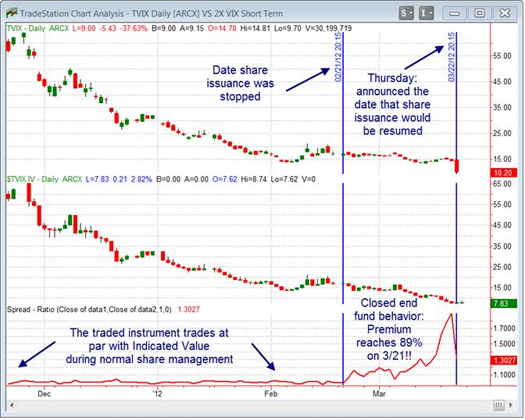
Thursday’s plunge (3/22) was in reaction to the press release from VelocityShares stating that Credit Suisse would start issuing new shares as soon as 3/23 (Friday). Thursday’s drop was the premium being sucked out in anticipation of TVIX moving back toward trading like a normal open ended-fund (and it almost completed that journey this morning).
The rest of the press release was a corporate-speak mea culpa for putting the screws to any and everyone who traded this thing in the interim. The share volume dropped from six days of trading 20-45MM shares per day just before the announcement to “only” 6-7MM shares per day during the last week. So while some people stopped buying this thing when it was trading at a premium as high as 89% above its Net Asset Value, clearly the message didn’t get out to traders in general.
Like you, we were long volatility through the TVIX, but when the shares were restricted, we switched over the UVXY. I hope this explanation helps.”
What You Can Do to Protect Yourself from ETP Mishaps
“Buyer beware” is a guiding principles of free markets. We should conduct our due diligence when we’re about to trade or invest in any instrument. In a previous article, I said I would share with you a trick that not 1 in 100 traders know. I shared this knowledge with the mentioned newsletter authors who shared it with their subscribers the next day.
ETP providers actually supply up-to-second NAVs for their instruments to data providers. So for any ETF or ETN that you’re considering, most trading platforms can show you not only the market price for the ETP, but also the NAV, which is called “Indicative Value,” or IV. And if you don’t have a trading platform that shows these values, you can get it from that ubiquitous provider of no-cost market info: Yahoo Finance. To find the IV for any ETP in Yahoo!, just use this convention:
^symbol-IV
So for TVIX, this would be ^TVIX-IV. The little “upside-down v” in front of the symbol is called a “carrot,” and you can find the symbol above the 6 on most keyboards. Different data providers may use a slightly different naming convention. For example, on TradeStation, it is “$TVIX.IV”.
The bottom line: be sure to compare the indicative value of any ETP that you’re considering. For example, one natural gas ETN (symbol: GAZ — iPath DJ-UBS Natural Gas TR Sub Idx ETN) is currently issuing no new shares. GAZ has been trading like a closed-end fund at a huge premium, and it too should be avoided until the issuer agrees to create new shares. The following chart shows the market price GAZ on top, the IV in the middle, and the premium between the two on the bottom:
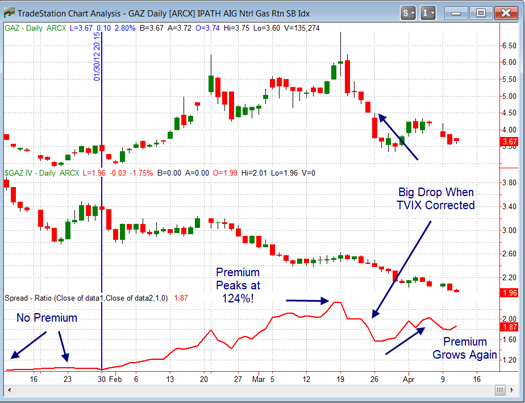
Forewarned is forearmed. Like the Disney World experience, ETPs have many benefits to recommend them. Just be aware that in rare instances, issuers can upset the apple cart, but savvy traders and investors have the tools to protect ourselves.
If you’ve found this article useful or thought-provoking (or both), I’d love to hear your thoughts and feedback. Just send an email to drbarton “at” vantharp.com. Until next week…
Great Trading,
D. R.
About the Author: A passion for the systematic approach to the markets and lifelong love of teaching and learning have propelled D.R. Barton, Jr. to the top of the investment and trading arena. He is a regularly featured guest on both Report on Business TV, and WTOP News Radio in Washington, D.C., and has been a guest on Bloomberg Radio. His articles have appeared on SmartMoney.com and Financial Advisor magazine. You may contact D.R. at "drbarton" at "vantharp.com".
Disclaimer
For Best Results, View On-Line
From Your Trading Coach
 What it Takes to Achieve Trading Mastery What it Takes to Achieve Trading Mastery
by Van K. Tharp, Ph.D.
Most of you have probably heard me say that trading isn’t easy. Considering how simple it is to go into a brokerage company, open an account, and, as soon as you figure out the buy and sell buttons, start trading, you’d think that even an E-Trade “baby” could do it. Without experience and training, though, your results would probably be disastrous.
We believe that good trading takes as much training as any other profession. In fact, Malcolm Gladwell suggests in his book Outliers that it probably takes 10,000 hours of great practice to really be “super” at anything. We tend to agree.
With that in mind, I wondered how much time it would really take someone to master all the material that we recommend. Do you have to master all of the material we offer? No, someone could trade competently without achieving mastery. By reaching trading competence, you could strive to consistently beat the market—as well as beat most professional money managers’ returns. (If you understood enough just to be in cash during bear market types, you would do better than most funds).
If someone did want to reach a mastery level, however, they would have a lot of work in front of them. Does the Van Tharp Institute have 10,000 hours of great practice as Gladwell suggests? Maybe. Recently, we expanded the Super Trader program from two years to as much as six years to give people more time to finish the entire set of graduation requirements. Let’s take a look at the program curriculum, starting with the basic material. The table below shows each of the items we recommend, what they cost, and the number of hours it would take to complete the course/workshop. Hours required includes the active time necessary after the workshop to really integrate the material. I estimated the number of times for mastery based on my experience of having Super Traders repeat workshops and courses before I believe they have fully integrated the knowledge.
Basic Concepts |
Cost |
Days |
Hours
Required |
Number of Times for Mastery |
Basic E-learning ABCs of Trading |
$50 |
1 |
4 hrs |
3 = 12 |
Tharp Think Workshop
Plus read core books (Super Trader and Trade Your Way to Financial Freedom) |
$595 |
5 |
40 hrs |
3 = 120 |
TOTAL Basic |
$645 |
6 days |
44 hours |
132 hours |
If you know nothing about trading, I recommend you take our ABCs of Trading e-Learning course first; it takes about 4 hours to go through and costs $50. Then I recommend reading books like Trade Your Way to Financial Freedom and Super Trader. Taking the Tharp Think workshop is also very helpful. “Tharp Think” refers to a set of principles that define the approach to trading I teach through my courses and workshops. Tharp Think involves discovering who you are as a trader, understanding risk, managing risk, and learning how to make your personal psychology work for you. Notice that mastering all of this takes about 132 hours, or nearly a month of full-time effort.
The next step is to master yourself, and this is the part that takes my Super Trader candidates a very long time. The next table includes my recommendations in this area.
Psychology / Spiritual Workshops and Courses |
Cost |
Number of Days |
Hours
Required |
Number of Times for Mastery |
Peak Performance 101 Workshop |
$2,995 ($700) |
3 |
40 hrs |
3 = 120 hrs |
Peak Performance 202 Workshop |
$3,995 ($700) |
4 |
60 hrs |
3 = 180 hrs |
Peak Performance 203 Workshop |
$3,995 ($700) |
3, plus 6-week follow-up |
140 hrs |
3 = 420 hrs |
A Course In Miracles book |
$30 |
1 hrs/day for 365 days |
365 hrs |
2 = 730 hrs |
Oneness Workshop |
$195 |
2 |
100 hrs |
5 = 500 hrs |
Libby Adam’s 28 day Transformation Course |
$7,500 ($1,505) |
28 days at 2.5 hrs per day = 8.75 workdays |
150 hrs |
2 = 300 hrs |
Peak Performance Home Study Course |
$795 |
2 mo. at 2 hr/day |
120 hrs |
3 = 360 hrs |
Peak Performance Home Study Course with Super Trader Lessons |
$795 plus ST |
20 hrs per lesson |
320 hrs |
1 = 320 hrs |
Total Psychology |
$19,505 |
20.75 days ++ |
1,295 hrs |
2,570 hrs |
The cost column includes the list price first and then the early enrollment discount we usually give in parentheses. “Hours Required” represents how many hours it usually takes to complete the course and all of its assignments. For example, the Peak 203 workshop is three days long, but it also has a series of follow-up activities that take six weeks; together, all of that takes about 140 hours to complete. However, most people need to take the workshop three times before fully mastering all of the material, so the total number of hours for Peak 203 is 3 x 140, or 420 hours.
I recommend that people take each of our psychological workshops as many as three times. Why? Because you get more out of them each time you take them. You evolve and change, so each instance ends up being like a different workshop (incidentally, for those interested in retaking a particular workshop to master the content, the Van Tharp Institute generally offers a 50% discount for your second time through. Call the office for details).
I put A Course in Miracles in the curriculum, but it could just as easily be the Sedona Method course, or anything else that you work on perhaps 1-2 hours per day. I’ve also given two examples of the Peak Performance Home Study Course. People probably spend about 120 hours on the course, but they also tend to skip a lot of the exercises or just skim over them—including most of the material that is critical for their personal growth. That’s why, when people finally get it, they have usually put in about 360 hours, or done it three times. The other alternative, which is to have me review 16 completed Super Trader lessons, is available for Super Trader candidates only.
Notice that the psychological section of the Super Trader program takes about 2,570 hours, or about 1.25 years of full-time work to complete. That may seem like a lot of effort, but the year of psychological work you do during this time improves everything in your life, including your trading.
We’ve found that people who skip the psychological section end up bringing all of their personal issues into trading and even into developing trading systems—which does not help them generate great results. That’s why we recommend that you do this work first. When you’ve completed it, you’ll find that you are a happier person and much more equipped to deal with all aspects of LIFE.
Let’s move on to the workshops and courses that cover important, basic trading topics, topics that apply to every trading business.
Global Workshops and Courses |
Days |
Cost |
Hours Required |
Number of Times for Mastery |
Blueprint Workshop |
3 |
$2,995 ($700) |
25-hr workshop + 125 hrs of assignments = 150 hrs |
2x25-hr workshop + 125 hrs = 175 hrs |
Systems Workshop |
3 |
$2995 ($700) |
50 hrs |
2 = 100 hrs |
| Systems Home Study Course |
2 hr/CD |
$795 |
48 hrs |
1 = 48 hrs |
Position Sizing Strategies (Definitive Guide book and Position Sizing eLearning Course) |
10 |
$395 |
50 hrs |
1 = 50 hrs |
Total Global |
7 days |
$7,180 |
298 hrs |
373 hrs |
The Blueprint Workshop gives you an overview of everything you need to be successful as a trader and prepares you to write a business plan. The workshop itself is about 25 hours long, but it probably takes 125 hrs (or more) to do all the exercises and complete a business plan, for a total of 150 hrs. Most Super Traders usually want to attend Blueprint a second time to finish off a truly great business plan, so the total number of hours required to complete the material is about 175.
I also recommend studying the Systems home study course and all of our material on position sizing™ strategies, which includes the Introduction to Position Sizing™ Strategies eLearning course and the Definitive Guide to Position Sizing™ book. To master all of the material in these workshops, courses and books would take about 373 hours, or about ten weeks of working at it full-time.
The next section of the Super Trader program is technical and trading-system-related. People seem to want to learn and trade good systems, so we have workshops in which you can learn great systems that conform to all of the Tharp Think principles and that have high SQN® numbers. You can see my recommendations for this area below.
Technical Workshops |
Cost |
Days |
Hours to Complete |
Number of Times for Mastery |
Mechanical Swing and Day Trading Systems Workshop |
$3,995 ($700) |
3 |
60 hrs |
1 w/live trading and simulations |
Core Trading Systems |
$2,995 ($700) |
2 |
50 hrs |
1 = 50 hrs |
Swing and Day Live Trading Workshop |
$3,500 |
5 |
60 hrs |
4 = 240 hrs |
Forex Systems Workshop |
$3,995 ($700) |
3 |
50 hrs |
1 = 50 hrs |
Bear Market Systems Workshop |
$3,995 ($700) |
3 |
50 hrs |
1 = 50 hrs |
Super Trader Systems Workshop |
$2,995 ($700) |
3 |
40 hrs |
1 = 40 hrs |
5 Individual System Simulation Workshops (3 days each) |
$14,975 ($3,500) |
15 |
150 hrs |
2 = 300 hrs |
TOTAL TECHNICAL |
$36,450 |
13 days (34 days in future) |
460 hrs |
790 hrs |
The Mechanical Swing and Day Trading Systems Workshop introduces all of Ken Long’s short-term systems that can be traded mechanically. His live trading workshop teaches how those same systems can be traded on a day-trading basis with some discretion. Ken teaches long-term systems that only require attention once a week or less in his Core Systems Workshop.
Gabriel Grammatidis returns in June to teach a three-day workshop on Forex Trading Systems. Since completing the Super Trader program several years ago, he has developed into a successful Forex trader who will share several of his rule-based trading systems at the workshop.
In addition to the four existing workshops, we have 21 days of new workshops planned. We’re also having several Super Traders present one of their primary systems in a Super Trader systems workshop happening later this fall. We are designing the Bear Market Systems Workshop to show you how to cope with volatile bear markets, and it will probably be ready by early 2013.
Finally, I’m a big believer in simulations. Curtis Faith noted in his recent book Trading From Your Gut that when he skydived, the free-fall portion of his jumps usually lasted less than 30 seconds. Jumping dozen of times over several days provides a jumper with only a few minutes of total free-fall time. But when he practiced in a simulator, he was able to get an equivalent of 120 jumps in just an hour. Well, that’s what we plan to do in our new series of trading simulation workshops. If each trade normally took you an hour to complete, you’d need 10,000 hours of excellent practice to reach mastery for a particular trading system. But what if each hour-long trade only took you ten minutes to complete? You’d be able to do those 10,000 trades in less than 2,000 hours. Our simulation workshops won’t get you all the way to mastery level, but they will get you to a level at which you can trade a particular system with competence in a matter of days. We expect to offer the first workshop of the simulation series in the second half of this year. The other simulation workshops are still in the idea phase.
Notice that I’ve listed 790 hours to master the technical section. That now puts our total of all three sections at 3,879 hours, or nearly two years of full-time work.
Now let’s look at the last section, which consists of Super-Trader-only workshops.
Super Trader Only Events |
Cost |
Days |
Hours to complete |
Total hours if mastered |
Super Trader Summit |
$5,000 |
3 |
60 hrs |
3 = 180 hrs |
Supercharger (oneness) |
$395 |
3 |
140 hrs |
3 = 420 hrs |
Options Workshop (recorded) |
$3,000 |
2 |
40 hrs |
3 = 120 hrs |
TOTAL Super Trader Only Events |
$8,395 |
10 days |
240 hrs |
720 hrs |
|
|
|
|
|
Total Training Cost and Time for Trading Mastery |
$72,175 ($12,500) |
43.75 days now
(21 more planned) |
2,337 hrs |
4,499 hrs or 2.25 years |
I recommend that most of our candidates attend the annual three-day Super Trader Summit at least three times. We also have what used to be the Trading in the Now workshop, which is really a Oneness workshop with an extra day focused on trading. In the future, it will only be a three-day Oneness workshop designed to supercharge them. In addition, last year we recorded a special two-day Options course, which we’ll show once each year.
The Super-Trader-only events add another 720 hours. Now we’re up to 4,485 hours, or 2.25 years to complete our curriculum. If you add to this another 5,000 hours of excellent trading on your own, you are at Malcolm Gladwell’s point of 10,000 hours.
Incidentally, I only realized just how much Super Traders save on our workshops and courses after I created the tables above. If you're not in the Super Trader program, the total cost for taking every course and workshop one time only is now $59,675 (after subtracting out the cost of the planned new workshops). Applying the workshop discounts we typically give brings the cost down to $52,075.
But Super Traders are permitted to take workshops (approved for their phase) as many times as they like while they're in the program, and the total price ranges from only $45,000 for four years to $65,000 for six years. Plus, they receive many other benefits, like my coaching time, the Super Trader lessons, the Super Trader Base Camp, Super Trader only events, just to name a few. The program is probably around a $200,000 value.
What if you don’t have $50,000 or 5,000-10,000 hours to devote to trading mastery in the next few years? Could you learn to trade successfully? That depends on your objectives and commitment. To reach competence, you would still need to understand the basics of trading, work on yourself a lot, write a solid business plan, develop and trade several systems. That’s still a significant investment of time and effort—likely several years.
Again, trading is like any other profession. If you want to earn a professional level wage for your efforts, you need to prepare yourself with experience and education. You can reach whatever level of achievement suits your objectives and commitments – you just have to do the work.
If you are a competent professional in a field other than trading, you’ve already gone through such a journey once. How much did your education and professional training cost you? Probably just as much—if not much more—in terms of time and money to reach a level of mastery in trading. In other words, having completed one journey, you can start another. Even if it seems like 1,000 miles, start with the first step.
Q & A
Question: What if what you’ve described is not for me because:
- I don’t have enough money to commit to anything like that.
- I don’t have the time to commit to anything like that.
- I can’t travel to come to workshops.
- I like my current job and want to stay with it.
- I’m not committed to being a full-time trader, but I want to outperform the S&P 500 each year.
If you don’t want to do the mastery-level amount of work and you’d just like to outperform your money manager and the S&P 500 each year, we have a number of easier recommendations.
- If you don’t know anything about trading, take our two e-Learning courses, the ABCs of Trading and Introduction to Position Sizing™ Strategies courses. You don’t have to travel to take these, and your cost is only $199.
- Read one book by Van Tharp, Super Trader, to get an overview of Tharp Think. It costs $25.
- Complete the Peak Performance Home Study Course to get a hold of your psychology. Here, the cost is $795.
- Take one two-day trading systems workshop, Core Trading Systems. The cost is $2,295 with the early enrollment discount.
If you do all of this, your total cost is $3,314 and your time invested is probably about 200 hours. Furthermore, if you trade systems from the Core workshop, you only have to make decisions once each week or once each month, quarter, or year (depending on the system) so the trading part is not a lot of work either.
Ken says this about one of his long-term trading systems:
Since 1999, I have been publishing a long-term, core investment system that I based on Tharp Think principles. It did very well during the Internet bubble. Discounting the exceptional performance of 1999 as an anomaly, it has returned the following annual performances, which have been published on a regular basis during that time.
Here are those performance results:
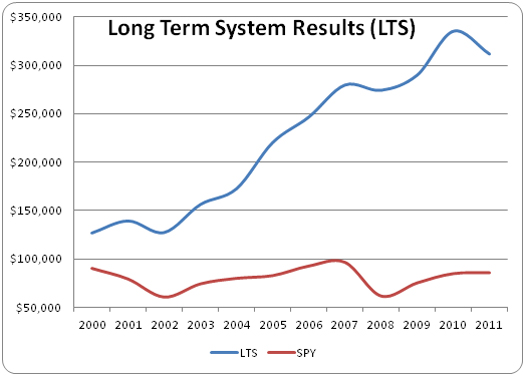
Year |
LTS |
SPY |
Jan 1 2000 |
$100,000
|
$100,000
|
End 2000 |
$126,600
|
$90,200
|
End 2001 |
$139,108
|
$79,268
|
End 2002 |
$127,117
|
$60,759
|
End 2003 |
$155,973
|
$74,241
|
End 2004 |
$172,225
|
$79,980
|
End 2005 |
$219,931
|
$82,779
|
End 2006 |
$246,301
|
$92,572
|
End 2007 |
$279,305
|
$96,451
|
End 2008 |
$273,915
|
$61,864
|
End 2009 |
$289,528
|
$75,282
|
End 2010 |
$334,810
|
$84,835
|
End 2011 |
$311,373
|
$85,683
|
Total Performance |
211.37%
|
-14.32%
|
Through twelve years, the SPY ETF (as a representation of the S&P 500) was down 14.317% while the LTS made 211.373%.
You’ll notice that LTS lost money in 2002, 2008, and 2011, but it outperformed the S&P 500 in two out of those three losing years. Most importantly, however, you’d be up more than 200% today from 2000 while the S&P 500 declined 14.3% over the same period.
For a 200%+ return, could you have tolerated three losing years out of the last twelve? If so, you would have beaten both the S&P 500 and most professional money managers. Will this system do well in 2012? We have no way of knowing, and if you used your equity to trade it now, it’s possible that the system could finish this year with a loss. This is about the best we can do for people who really don’t want to do a lot of work or spend a lot of time on trading.
Incidentally, the Core Trading Systems workshop is coming up; the early enrollment discount for it ends very soon.
Question: So what if I’m willing to come to a few workshops?
Then we recommend you attend Peak 101 and Blueprint. We have three more P101 workshops this year but only one Blueprint in 2012, which is later this month.
Question: What if I attended the Core workshop last year, traded Ken’s once-a month system, but lost money even though Ken made money with the same system? The only differences were times when I entered or exited certain positions a little early or a little late. I didn’t lose a lot of money, but those seem to have really hurt my results
You weren’t following your trading system’s rules. Each time you don’t, you can label that a mistake. Once you realize you are making mistakes and probably repeating them, you arrive at our fundamental viewpoint—that most people need to work on their psychology to trade well. For that, I recommend that you work through the Peak Performance Home Study Course three or four times and take Peak 101, Peak 202, and Peak 203.
Question: What if I’d like to get a broad overview?
Then we recommend our Basic Trader bundle at $5100. You can check it out at the following link. https://vanktharp.com/products/basic-trader-program.asp.
About the Author: Trading coach, and author, Dr. Van K. Tharp is widely recognized for his best-selling books and his outstanding Peak Performance Home Study program—a highly regarded classic that is suitable for all levels of traders and investors. You can learn more about Van Tharp at www.vantharp.com.
Trading Education
Workshops
$700 Discounts Expire Next Week on Core Trading Systems Workshop and Blueprint Workshops
Apr
21-22 |
$2,295
$2,995
|
Core Trading Systems: Market Outperformance and Absolute Returns
Longer Term Systems for Consistent Trading Profits |
Cary, NC |
Apr
24-26 |
$2,295
$2,995
|
Blueprint for Trading Success
Build the Foundation of Successful Trading |
Cary, NC |
Apr
28-29 |
$195 |
Oneness Awakening Workshop
Become more positive, calm, and centered
|
Cary, NC |
May
17-19 |
$2,295
$2,995
|
Peak Performance 101
Van Tharp's Signature Workshop |
Cary, NC |
May
21-24 |
$3,295
$3,995
|
Peak Performance 202
with Dr. Libby Adams |
Cary, NC |
June
14-16 |
$3,295
$3,995
|
Forex Trading
New! Three-Day Workshop |
Cary, NC |
June
18-20 |
$2,295
$2,995
|
How to Develop A Winning Trading System That Fits You
with Van and RJ Hixson |
Cary, NC |
To see our full workshop schedule including dates, prices, and location, click here.
Also, see dates for Aug-Oct
Ask Van...
Everything we do here at the Van Tharp Institute is focused on helping you improve as a trader and investor. Consequently, we love to get your feedback, both positive and negative!
Click here to take our quick, 6-question survey.
Also send comments or ask Van a question by using the form below.
Click Here for Feedback Form »
Back to Top
Contact Us
Email us at [email protected]
The Van Tharp Institute does not support spamming in any way, shape or form. This is a subscription based newsletter.
To change your e-mail Address, click here
To stop your subscription, click on the "unsubscribe" link at the bottom left-hand corner of this email.
How are we doing? Give us your feedback! Click here to take our quick survey.
800-385-4486 * 919-466-0043 * Fax 919-466-0408
SQN® and the System Quality Number® are registered trademarks of the Van Tharp Institute
Back to Top |
|
April 11, 2012 - Issue 572
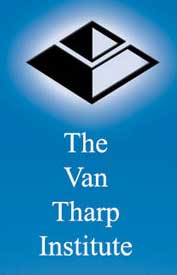

A Must Read for All Traders
Super Trader
How are we doing?
Give us your feedback!
Click here to take our quick survey.
From our reader survey...
"I think the newsletter is extremely generous and it is a resource I utilize constantly. I have saved every single one since I first subscribed."
Trouble viewing this issue?
View On-line. »
Tharp Concepts Explained...
-
Trading Psychology
-
System Development
-
Risk and R-Multiples
-
Position Sizing
-
Expectancy
-
Business Planning
Learn the concepts...
Read what Van says about the mission of his training institute.
The Position Sizing Game Version 4.0
Picking the right stocks has nothing to do with trading success and neither do amazing trading systems with high percentage wins. The Position Sizing Game teaches you the key elements of trading success. Learn more.
To Download for Free or Upgrade Click Here

Download the 1st three levels of Version 4.0 for free.
Register now. »
Trouble viewing this issue?
View On-line. »

A Thousand Names for Joy: A Commentary
You can read Super Trader Curtis Wee's full review here.
Dr. Tharp is on Facebook
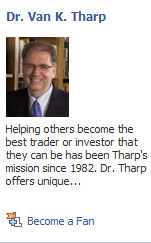
Follow Van through
Twitter »
Van Tharp Trading Education Products are the best training you can get.

Check out our home study materials, e-learning courses, and best-selling books.
Click here for products and pricing
What kind of Trader Are You? Click below to take the test.
Tharp Trader Test
Back to Top

Introduction to Position Sizing™ Strategies
E-Learning Course
Only $149
Learn More
Buy Now
SQN® and the System Quality Number® are registered trademarks of the Van Tharp Institute |